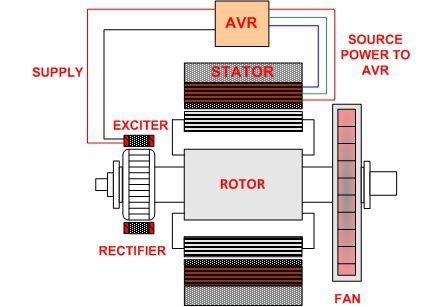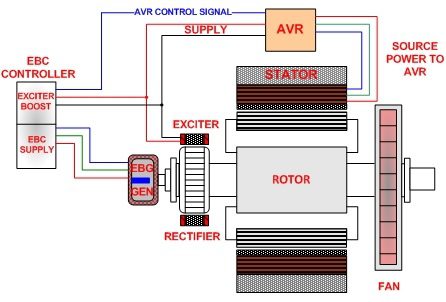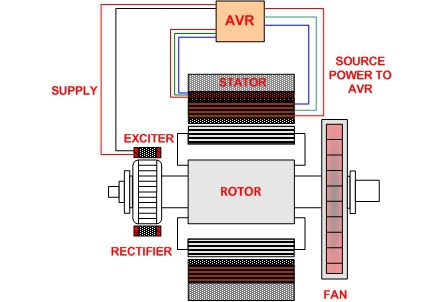Excitation Systems
Excitation systems can be defined as the system that provides field current to the rotor winding of a generator. Well-designed excitation systems provide reliability of operation, stability, and fast transient response.
The Four Common Excitation Methods
The four common excitation methods include:
- Shunt or Self Excited
- Excitation Boost System (EBS)
- Permanent Magnet Generator (PMG)
- Auxiliary Winding (AUX)
Each method has its individual advantages. All methods use an Automatic Voltage Regulator (AVR) to supply DC output to the exciter stator. The exciter rotor AC output is rectified to a DC input for the main generator rotor. More advanced systems use an additional input to the AVR. This article will explore the construction, function, and application for each method and includes diagrams and illustrations for each.
Automatic Voltage Regulator (AVR)
The construction of the AVR varies with the excitation used. All receive input from the stator of the generator when it rotates. AVRs with the capability of receiving a second input to reduce or eliminate internal harmonics caused by load feedback signals are used for non-linear load applications.
Two Common Types of AVRs
- Silicone Controlled Rectifier (SCR)
- Senses power level from the stator and determines its firing for the exciter voltage.
- Can cause troubles when used with non-linear loads.
- Field Effect Transistor (FET)
- Senses power level from the stator and translates it into a Pulse Width Modulated (PWM) signal to the exciter.
- This style of AVR can be used for excitation methods. Non-linear loads do not cause feedback resulting in excitation breakdowns.
Shunt or Self-Excited

Shunt Excitation
The shunt method features a simple and cost-effective design to provide input power to the AVR. This method requires no additional components or wiring. When problems arise, troubleshooting is simplified with fewer components and wiring to validate.
As the generator is rotated, the stator supplies input voltage to the AVR. In addition, the AVR has sensors that monitor the output of the stator.
The AVR supplies power to the exciter, which is rectified to DC current. The current is induced onto the stator for load output.
Drawbacks of Shunt Excitation
- The AVR is impacted by the load the generator is powering.
- Increased load decreases voltage, forcing the AVR to supply more current. If pushed beyond its limits, the excitation field collapses.
- If a short circuit occurs in the AVR supply, the generator will lose its excitation source, causing a loss of generator power output.
Application: Generators with shunt excitation are suitable for linear loads (constant load) but not recommended for non-linear loads. Harmonics associated with non-linear loads can cause excitation field breakdowns.
Excitation Boost System (EBS)

EBS Excitation
The EBS system comprises the same basic components supplying inputs to and receiving outputs from the AVR.
Additional Components in the EBS System
- Excitation Boost Control (EBC) Module
- Excitation Boost Generator (EBG)
The EBG is mounted on the driven end of the alternator and appears similar to a permanent magnet. It supplies power to the controller as the generator shaft rotates.
The EBC control module is connected in parallel to the AVR and the exciter. It receives a signal from the AVR and supplies varying levels of excitation current as needed.
Benefits of EBS:
- Supports load requirements, allowing the generator to start and recover excitation voltage.
- Provides dynamic response and is cost-effective.
- Capable of delivering 300% short circuit current.
Limitations: Not recommended for continuous power applications; intended for emergency or backup power use.
Permanent Magnet Generator (PMG)
PMG Excitation

Generators equipped with permanent magnets are among the most well-known separately excited methods. A permanent magnet is mounted on the driven end of the generator shaft.
The PMG supplies isolated power to the AVR when the generator shaft rotates. The AVR uses this power when supplying non-linear loads, such as motor startups.
Benefits of PMG Excitation
- Excitation field does not collapse, allowing for sustained short circuit faults.
- Changing loads do not impact the excitation field.
- Voltage is created at initial startup and does not rely on remaining magnetism.
- Prevents excitation collapse during motor startups.
Note: The PMG system adds weight and size to the generator end. It is the most commonly used excitation method for applications with motors or non-linear loads.
Auxiliary Winding (AUX)
Auxiliary Winding Excitation

The auxiliary winding method has been used for years, particularly in marine and industrial applications. It is more practical in larger installations.
Unlike PMG, this method does not use components attached to the driven end of the generator shaft. Instead, an additional single-phase winding is installed in the stator.
How It Works
- The main windings of the stator supply voltage to the AVR.
- Additional single-phase windings supply the extra excitation voltage needed when serving non-linear loads.
Excitation Methods for Load Types
Linear Load Applications
For linear loads, the following excitation methods can be used:
- Shunt (most cost-effective)
- EBS
- PMG
- AUX
Non-Linear Load Applications
For non-linear loads, the following excitation methods are recommended:
- EBS
- PMG (most common and widely used)
- AUX